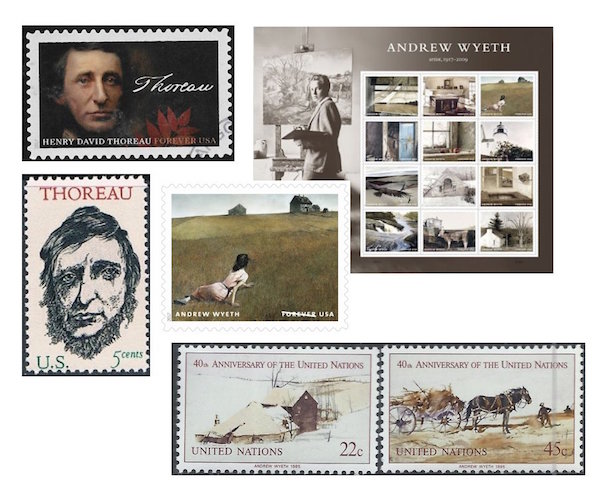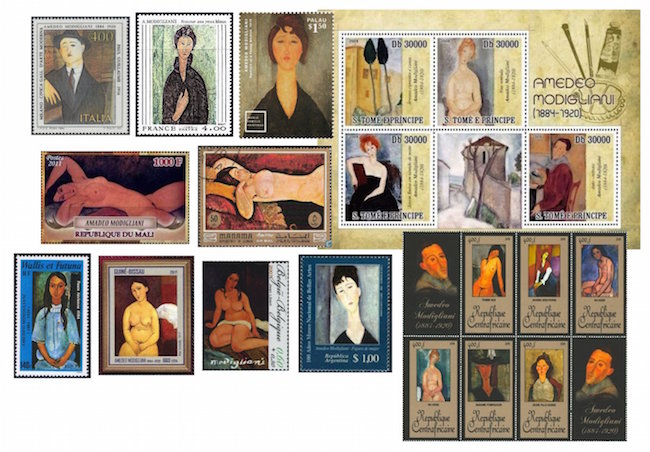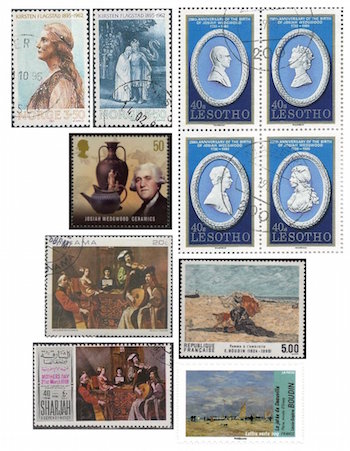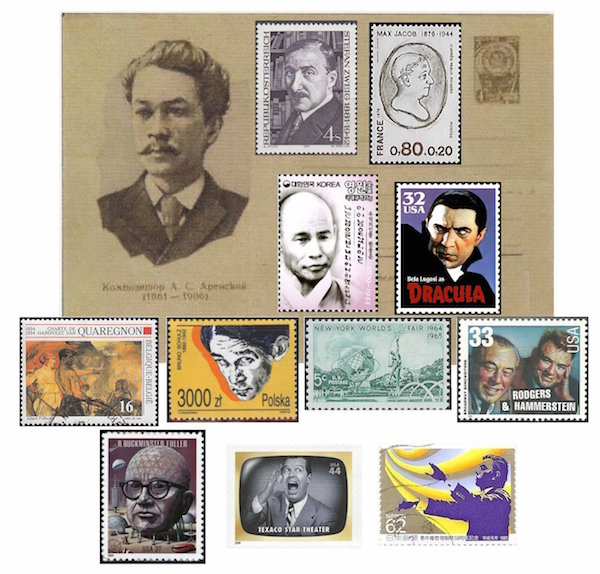The Arts on Stamps of the World — July 12
An Arts Fuse regular feature: the arts on stamps of the world.

By Doug Briscoe
What a day! Not only is today the bicentenary of the birth of Henry David Thoreau and the centenary of Andrew Wyeth, but beyond that we have an almost incredible roster of talent for today’s Arts on Stamps of the World: Amedeo Modigliani, Pablo Neruda, Kirsten Flagstad, Josiah Wedgwood, Oscar Hammerstein II, Stefan George, Max Jacob, Tod Browning, Bruno Schulz, Buckminster Fuller, and Milton Berle! All of them on stamps (well, I cheated a little to squeeze Tod Browning in). To that stunning lineup add French painters Nicolas Tournier and Eugène Boudin, Russian composer Anton Arensky, Korean poet Han Yong-un, Belgian painter Fernand Allard l’Olivier, American landscape architect Gilmore David Clarke, and Japanese composer and conductor Yasushi Akutagawa. I guess I don’t get a lunch break.

This year, to celebrate the centesimal anniversaries of Henry David Thoreau (July 12, 1817 – May 6, 1862) and Andrew Wyeth (July 12, 1917 – January 16, 2009), the United States Postal Service has issued a stamp and a sheet, respectively. The Thoreau stamp was released earlier this year, and the Wyeth sheet is being issued today (#WyethStamps and #MyBrandywine). In addition to a reduced size image of the sheet, I present a larger one of Wyeth’s most famous work, Christina’s World (1948). In 1985, for the 40th anniversary of the United Nations, two Wyeth paintings were selected for a pair of stamps: The Corner and Alvaro Raking Hay. I show also an earlier Thoreau stamp from fifty years ago.

As for Modigliani and Neruda, each gets a page to himself. One gets a distinct sense from a cursory examination of the stamps of Amedeo Modigliani (12 July 1884 – 24 January 1920) that he had an eye for the ladies. Indeed, from the stamps alone, one might get the idea that Modigliani painted little else and never sculpted a single shape. In fact, of course, he made many portraits, often of well-known figures such as Léon Bakst, Jean Cocteau, Diego Rivera, Chaim Soutine, and Max Jacob (see below), along with the many pictures of his gorgeous mistress Jeanne Hébuterne, who committed suicide days after Modigliani succumbed to tubercular meningitis at the age of 35. She was only 21 and pregnant with their second child. As for his sculptures, they seem to have been completely eschewed by stamp designers. But we can hardly complain of neglect, except I find it odd that Modigliani’s native Italy seems to have produced but a single stamp in his honor, and that one of his three portraits of the art dealer Paul Guillaume, this one from 1916. France gives us Woman with blue eyes (1918), and Palau Portrait of a Young Woman (1919). On the sheet from São Tomé are, unexpectedly, two exteriors: Houses and Cypresses (undated) at upper left and Tree and House (1919) at bottom center (not a stamp; notice absence of text and denomination); Sitting nude with hands in lap (1918, also reproduced on the sheet from the Central African Republic below); Redheaded girl in evening dress; and Self-portrait (1919), a detail of which is at the corners of the CAR sheet. Two reclining nudes, both from 1917, are found on stamps of Mali and Manama; one of the artist’s children’s portraits, Alice (1915), on a very pretty stamp from Wallis and Futuna; two seated nudes, both, again, from 1917, are on stamps of Guinea-Bissua and Belgium; and on the Argentine stamp Figure of a Woman. On the CAR sheet are Female nude: Iris Tree (c1916), Jeanne Hébuterne before a door (1919), Seated Nude (1909), and at bottom center, Madame Pompadour (1915) and Young girl seated (1918).

I’ve remarked on the fact that painters usually get the glory over writers on stamps, now here to prove the exception is Pablo Neruda (1904 – September 23, 1973), who as you can see has a slew of international stamps. He was born Neftalí Ricardo Reyes Basoalto and derived his pen name (which he later adopted as his legal name as well) from the 19th-century Czech poet Jan Neruda (whose birthday, by the way, was just three days ago). An outspoken leftist, he had to go into hiding when President González Videla outlawed communism in Chile in 1948; after being hidden by friends in Valparaíso for months, Neruda escaped into Argentina. Much later he served as an advisor to Salvador Allende. When Augusto Pinochet staged his military coup, Neruda was already in the hospital with cancer, and he died at home twelve days later. Pinochet forbade a public funeral, but thousands of Chileans ignored the ban. Two years earlier, Neruda had won the Nobel Prize for Literature. Some of the music Neruda inspired includes the cantata “The Lovers” (1971) by Samuel Barber, Allan Pettersson’s Twelfth Symphony, subtitled “The Dead in the Marketplace” (1973-4), Tobias Picker’s Tres Sonetos de Amor (2000), and the late Peter Lieberson’s Neruda Songs (2005) and Songs of Love and Sorrow (2010). The late Mexican composer Daniel Catán wrote an opera Il Postino (2010), based in part on the film of the same name. Plácido Domingo sang the rôle of Neruda in the première and on DVD. As for the stamps, besides the Chilean examples, they have tended, not surprisingly, to come from Latin American and/or formerly Communist countries.
Kirsten Flagstad (1895 – 7 December 1962) was one of the most important and admired singers of the twentieth century. She was particularly associated with Wagnerian rôles, though in her early years she concentrated on less taxing repertoire. She made her debut in Oslo in 1913, appeared at the Bayreuth Festival in 1933, and made her Met debut in 1935 in a broadcast performance of Die Walküre, which caused a sensation. Among her many accomplishments, she gave the world première of Richard Strauss’s Four Last Songs in 1950 and was the first Director of the Norwegian National Opera. She left many recordings, with the Furtwängler Tristan among her greatest.
Though his innovations in entrepeneurship are not the reason for his inclusion in our survey, Josiah Wedgwood (12 July 1730 – 3 January 1795) is credited by Wikipedia with introducing the concepts of “direct mail, money back guarantees, travelling salesmen…self-service, free delivery, buy-one-get-one-free, and illustrated catalogues.” The English potter made elegant pieces much in demand by the upper crust, then invented techniques to produce copies inexpensively for the less affluent. He was also Charles Darwin’s grandfather. We have a British stamp and a sheet of his cameos from Lesotho.
French painters Nicolas Tournier and Eugène Boudin were respectively baptised and born on July 12th, albeit centuries apart. Tournier (1590 – d. before February 1639) was born in Montbéliard near the Swiss border, worked in Rome from 1619 to 1626, and thereafter lived in the south of France. His painting Le Concert (1630-35) is reproduced on stamps of both Panama and Sharjah. One of his paintings, The Carrying of the Cross (c1632), was stolen in 1818 and after being lost for two centuries showed up in 2009. Eugène Boudin (12 July 1824 – 8 August 1898), much admired by Baudelaire and Corot, painted the sea, the shore, the harbor. He was born at Honfleur and usually worked outdoors, most unusual at the time. As a boy he worked in his father’s picture framing shop, where he met Millet and others. He in turn later befriended and mentored the young Monet. Like Tournier, Boudin spent his later years in the south of France, but returned north just before his death in Deauville. The two French stamps show Boudin’s Woman with umbrella and The Jetty at Deauville.
Born in Novgorod, Anton Arensky (12 July [O.S. June 30] 1861 – 25 February [O.S. 12 February] 1906) studied composition with Rimsky-Korsakov at the Saint Petersburg Conservatory, later taking up a post at the Moscow Conservatory, where his students included Scriabin and Rachmaninoff. His best known works are the ballet Egyptian Nights and the Variations on a Theme of Tchaikovsky. One of his three operas was written to a libretto by Tchaikovsky’s brother Modest. He died of tuberculosis in a sanatorium in Finland at the age of 44. There is no stamp per se, but we can make do with this postal card.
On a day of such huge talents, poets of the caliber of Stefan George (1868 – 4 December 1933) and Max Jacob (1876 – 5 March 1944) are shoved off the front page, where otherwise they might shine. George (pron. gay-OR-geh) founded a literary magazine in the 1890s and became the center of a literary circle named for him. His work was used in musical compositions by Schoenberg (String Quartet No. 2, The Book of Hanging Gardens) and Webern. Besides his own poetry, George translated Dante, Shakespeare, and Baudelaire into German. When the Nazis came to power he declined an offer from Goebbels to head a new academy for the arts and repaired to Switzerland, where he died shortly thereafter. A man who celebrated self-sacrifice (thus his appeal to Goebbels), he was a celibate homosexual who urged young gays to follow his example. Max Jacob, meanwhile, was a painter, critic, and novelist as well as a poet. A friend of Modigliani (see above), he was an intimate also of Picasso and Cocteau. Of Jewish ancestry, Jacob converted to Catholicism in 1909 (after supposedly experiencing a vision). Arrested early in 1944 by the Gestapo, and while awaiting transport to Auschwitz, he died in an infirmary of, it is said, bronchial pneumonia.

Another poet, Han Yong-un (July 12, 1879 – May 9, 1944), was a Korean Buddhist who used the pen name Manhae. He was a nationalist who took part in the struggle for independence from Japan and spent three years in prison for his sentiments. His greatest work is held to be the collection Nimui Chimmuk (Lover’s Silence, 1926), which, much under the influence of Rabindranath Tagore, combines political, mystical, and erotic elements. Han also wrote at least three novels. Ironically, perhaps, he died just two months after Max Jacob.
American director Tod Browning (July 12, 1880 – October 6, 1962) has, as of yet, no stamp of his own, so we offer instead one associated with one of his most famous films. Browning is also renowned for his creepy silent The Unknown (1927), one of ten films he made with Lon Chaney, and, of course, the notorious Freaks (1932). By the way, Browning’s very next movie, although he is uncredited as the director, was Fast Workers, starring John Gilbert, whose birthday we observed here the day before yesterday.
The Belgian painter Florent-Joseph-Fernand Allard (12 July 1883 – 9 June 1933) assumed the name Fernand Allard l’Olivier. As a young man he developed a style French Wikipedia describes as “décorative et monumentale.” He was an official painter during World War I, capturing in his art his companions, infirmaries, and destroyed villages. After the war he continued producing canvases but also worked in commercial art, book illustrations, and theater. On two trips to the Belgian Congo in 1928 and 1932-33, he provided propagandistic pieces portraying persistently happy natives. His painting Fall of the Golden Calf was used in 1994 to mark the centennial of the socialist political manifesto the Charter of Quaregnon.
Sharing much in common with Max Jacob, Polish artist Bruno Schulz (July 12, 1892 – November 19, 1942) was Jewish, a writer, a painter (of murals), and a critic and was persecuted by the Nazis, in Schulz’s case, being shot to death in the street by a Gestapo officer. His surviving work amounts to two story collections, one in the form of a novel, some essays and letters, and a mural Schulz had painted that was rediscovered in 2001.
American engineer Gilmore David Clarke (July 12, 1892 – August 8, 1982) was a landscape architect who was responsible for a number of New York City’s parks, the Central Park Zoo, and the Conservatory Garden. He was also in charge of landscape architecture for the 1939 World’s Fair and, decades later, contributed to the 1964 Fair, for which he designed the Unisphere, as seen on the stamp from that year.

The author of some 850 song lyrics, Oscar Hammerstein II (July 12, 1895 – August 23, 1960) famously collaborated with Jerome Kern (Show Boat, 1927) and Richard Rodgers (Oklahoma!, Carousel, The King and I, South Pacific, Flower Drum Song, The Sound of Music), among numerous others. He was the winner of eight Tony awards and two Oscars (for “The Last Time I Saw Paris” in Lady Be Good and “It Might as Well Be Spring” in State Fair).
Buckminster Fuller (July 12, 1895 – July 1, 1983), a builder of clever contraptions in childhood, was more of a thinker, theorist, and inventor than an artist, but in 1928 he did decorate the interior of Romany Marie’s café in Greenwich Village, where he met Eugene O’Neill and, soon after, Fuller’s collaborator, sculptor Isamu Noguchi. Fuller is perhaps most noted for having popularized (not invented) the geodesic dome, cleverly incorporated into the portrait on the stamp.
Milton Berle (July 12, 1908 – March 27, 2002) was born Mendel Berlinger and changed his name when he was sixteen, long after his entry into show business. He was a child actor in the silents, including The Perils of Pauline (1914). In an unusual reversal, it seems he played in vaudeville after his start in the movies; then it was radio and television, where he effectively reigned as America’s first TV star, “Uncle Miltie”.
Japanese composer and conductor Yasushi Akutagawa (1925 – January 31, 1989) entered the Soviet Union illegally in 1954 and befriended Shostakovich, Khachaturian, and Kabalevsky. His works include the opera Orpheus in Hiroshima, ballets, orchestral and film music. Akutagawa is not identified on the stamp because its primary purpose was to recognize the 50th anniversary of the Japanese Copyright Control System. Akutagawa had died in January, 1989, and when the stamp was issued in November, it was decided to pay him tacit tribute.
A graduate of the University of Massachusetts with a B.A. in English, Doug Briscoe worked in Boston classical music radio, at WCRB, WGBH, and WBUR, for about 25 years, beginning in 1977. He has the curious distinction of having succeeded Robert J. Lurtsema twice, first as host of WGBH’s weekday morning classical music program in 1993, then as host of the weekend program when Robert J.’s health failed in 2000. Doug also wrote liner notes for several of the late Gunther Schuller’s GM Recordings releases as well as program notes for the Boston Classical Orchestra. For the past few years he’s been posting a Facebook “blog” of classical music on stamps of the world, which has now been expanded to encompass all the arts for The Arts Fuse.
